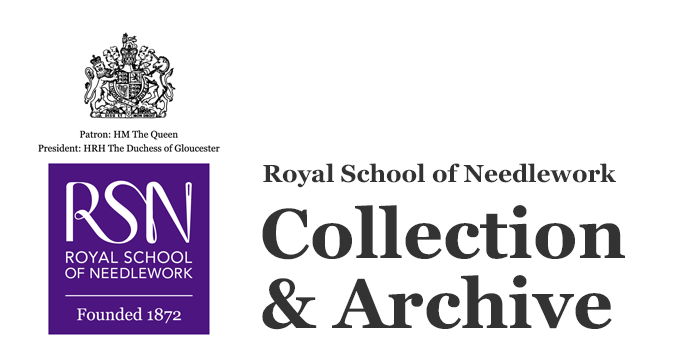Fragment
Object name
Date made
Late 17th century-early 18th century
Place made
Description
Fragment of late 17th or early 18th-century English crewelwork, depicting a stylised flower in blue wool thread.
Content description
Late 17th or early 18th-century fragment of crewelwork embroidery. The design on this fragment is largely of a single flower form. All of the outlines are worked in either plaited braid or heavy chain stitch. It is also possible the stitch in question is a sort of buttonhole stitch over a laid thread. It is not possible to be certain what stitch this is without seeing the reverse of the stitch, which is not feasible due to its being stitched into the Grove Book. Eleven petals surround the heart of the flower where there are three smaller petals with shading effects created by bullion knots, seeding stitches, and detached chain stitches. Three large petals project forward from the centre; one is filled with detached chain stitch and the two either side are filled with a combination of detached chain with strings of seeding stitch weaving between them. Four petals rise up from the centre, one filled with a combination of detached chain stitches with French knots in the middle and cross stitches. The second has lines made from straight stitches and running stitches and the third has a vein effect made with coral stitch interspersed with French knots. The fourth petal contains a repeated motif which uses French knots and straight stitch arranged in a floral design. This design is repeated inside a further petal on the left hand side of the flower beside a second petal using coral stitch and French knots in a striped design. A final double sized petal sits at the top of the flower. A series of five circles run down the centre, each made with a ring of French knots and a star form in the centre. Running up either side of the circles are two lines of seed stitches which mimic the shape of the circles, a row of detached chain stitches and then a further row of seed stitches.
The bottom left of the fabric has a segment of a further flower that appears to run to the edge of the embroidery design. One petal contains cross stitches, the second appears to contain some form of closed herringbone stitch which is in poor condition, and the final petal has a trellis stitch creating more dense coverage than any other petals in the piece.
British wool embroidery such as this example is known as crewelwork or crewel embroidery. Crewelwork was a very popular method of decorating domestic textiles in the 16th, 17th, and 18th centuries. In the period in which this fragment was made, the late 17th and early 18th centuries, many crewelwork designs were inspired by the Tree of Life motif present on painted Indian palampores which were being imported into Britain. These crewelwork embroideries exhibited curling vines, large leaves in a variety of shapes, and, sometimes, flowers. This fragment was certainly part of this trend. Some crewelwork embroideries also took inspiration from Chinese decorative arts and featured chinoiserie pavilions, birds, and figures. Many examples, such as this one, have a blue and white palette, reminiscent of the Chinese export and Dutch Delft ceramics that were hugely popular in England in this period.
This fragment and several other pieces of contemporary English crewelwork are housed within the Grove Book, a collection of textile pieces gathered by Georgina Grove while she travelled around Europe and India with her husband, Brigadier General Edward Aickin William Stewart Grove husband, in the late 19th century. The Grove Book was given to the RSN upon Georgina's death in 1924.
The bottom left of the fabric has a segment of a further flower that appears to run to the edge of the embroidery design. One petal contains cross stitches, the second appears to contain some form of closed herringbone stitch which is in poor condition, and the final petal has a trellis stitch creating more dense coverage than any other petals in the piece.
British wool embroidery such as this example is known as crewelwork or crewel embroidery. Crewelwork was a very popular method of decorating domestic textiles in the 16th, 17th, and 18th centuries. In the period in which this fragment was made, the late 17th and early 18th centuries, many crewelwork designs were inspired by the Tree of Life motif present on painted Indian palampores which were being imported into Britain. These crewelwork embroideries exhibited curling vines, large leaves in a variety of shapes, and, sometimes, flowers. This fragment was certainly part of this trend. Some crewelwork embroideries also took inspiration from Chinese decorative arts and featured chinoiserie pavilions, birds, and figures. Many examples, such as this one, have a blue and white palette, reminiscent of the Chinese export and Dutch Delft ceramics that were hugely popular in England in this period.
This fragment and several other pieces of contemporary English crewelwork are housed within the Grove Book, a collection of textile pieces gathered by Georgina Grove while she travelled around Europe and India with her husband, Brigadier General Edward Aickin William Stewart Grove husband, in the late 19th century. The Grove Book was given to the RSN upon Georgina's death in 1924.
Dimensions
width: 21cm
height: 15cm
height: 15cm
Materials
Stitches
Detached chain stitch 
Bullion knot
Seeding stitch
French knot
Straight stitch
Coral stitch
Cross stitch
Trellis

Bullion knot

Seeding stitch

French knot

Straight stitch

Coral stitch

Cross stitch

Trellis

Techniques
Motifs
Credit line
Gift of Brigadier General Edward Grove, 1924.
Catalogue number
COL.1924.20.Grove.2
© Royal School of Needlework
